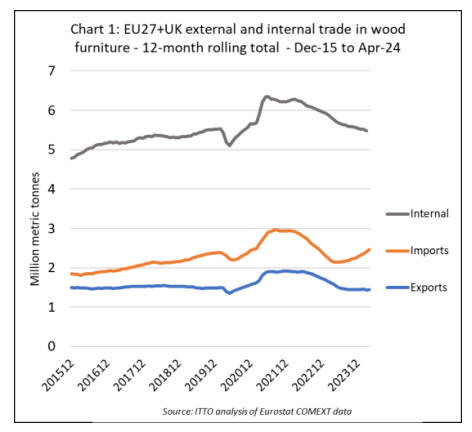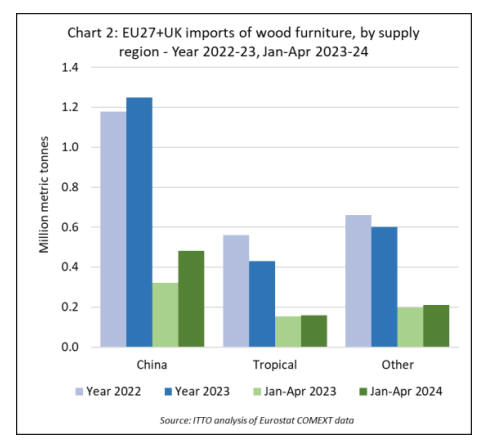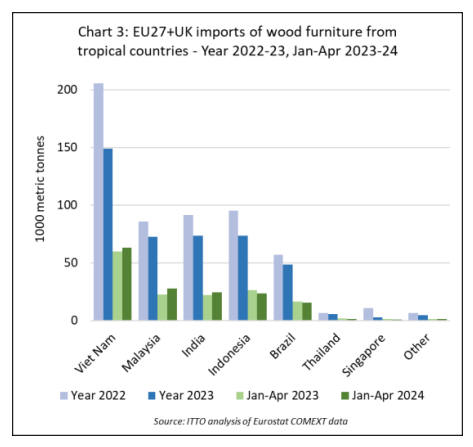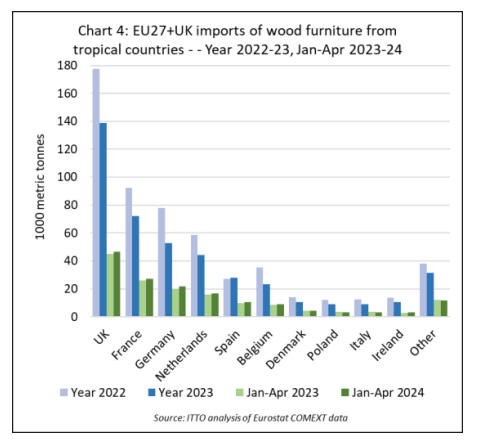|
Report from
Europe
Rethinking trategy for Europe’s furniture sector
Europe continues to perform a key role in the global
furniture trade and industry, but that role is shifting as
European operators seek to reduce risk by shortening
supply chains and with introduction of new environmental
regulations. For wooden furniture, the EU Deforestation
Regulation (EUDR) is likely to play a particularly
significant role in future procurement practices.
In global terms Europe has lost ground to emerging
markets in furniture production and consumption in recent
years. However, it remains the world’s third-largest
market after Asia Pacific and North America. With more
than 230 million households, a relatively high level of per
capita consumption, and annual retail furniture sales of
EUR 165 billion, Europe accounts for over a quarter of the
global world furniture market.
This is according to the latest edition of the World
Furniture Magazine published by CSIL, the Italian
furniture industry research organisation.
See: https://www.worldfurnitureonline.com/magazine/)
A key feature of the European furniture sector, according
to CSIL, is that it is characterised by an exceptionally high
level of business-to-business trade concentration and
integration: as much as three quarters of cross-border
furniture trade worldwide occurs between European
countries where there is a robust intra-regional trade
network. And unlike in the U.S. where a large share of
furniture production has been relocated to China,
Southeast Asia and Mexico, 80% of current demand in
Europe continues to be met by European manufacturers.
As elsewhere in the world, Europe’s furniture market
exhibited robust growth during the pandemic in 2021 as
consumers spent heavily to improve their home
environment, establish home offices, and improve outside
space. Economic support measures in the immediate
aftermath of the pandemic continued to fuel the boom into
2022, but the market decelerated rapidly in 2023.
According to the latest figures from CSIL, the overall
value of furniture consumption in Europe contracted by
3.5% last year.
CSIL note that the European furniture sector has faced a
multitude of challenges since the pandemic outbreak with
disruptions along the entire value chain. Since 2023, the
rising cost of living has intensified pressure on consumer
spending, particularly for big-ticket items such as
furniture. At the same time, major logistical challenges,
volatility in transport costs, and other supply problems
forced furniture manufacturers and retailers to rethink their
business strategies.
Most furniture companies surveyed by CSIL in 2023 said
they are actively working to shorten supply chains and
increase dependence on local production to reduce risk
and shorten time to market. Within Europe, Portugal, Italy,
and Spain have particularly benefited from this trend.
Chinese wooden furniture recovers ground in Europe
However, the latest Eurostat and UK trade data appears, at
first sight, to partially contradict this analysis. The data
shows that internal European trade in wooden furniture
has been slowing continuously since the start of 2023,
very much in line with the wider decline in consumption.
It also shows that European exports of wooden furniture to
countries outside the region, after falling rapidly in 2022,
have remained flat since the second quarter of 2023. But it
also shows that European imports from other parts of the
world have been increasing since the middle of last year
(Chart 1).

Closer analysis of the data reveals that the recent growth
in wooden furniture imports into the EU27+UK has been
driven by China. Imports into Europe from China
increased by 6% to 1.25 million tonnes in 2023 and were
up by more than 50% at 480,000 tonnes in the first four
months of this year.
In contrast imports from tropical countries fell by 23% to
430,000 tonnes in 2023 and were up only 4% in the first
four months of this year. Imports from all other countries
(mainly non-EU European countries and Turkey)
decreased 9% to 600,000 tonnes in 2023 and increased by
7% to 210,000 tonnes in the January to April period this
year (Chart 2).

Wooden furniture imports from China have increased both
into the UK, the largest single wooden furniture importing
country in Europe, and into the EU. UK imports from
China increased 13% to 417,000 tonnes in 2023 and were
up another 34% to 152,000 tonnes in the first four months
of this year.
EU imports from China were up only 3% in 2023 to
833,000 tonnes but increased 59% to 331,000 tonnes in the
first four months this year. Imports of wooden furniture
from China have increased very sharply into all the main
EU markets this year including France, Germany, and the
Netherlands.
EUDR to significantly impact Europe’s wooden
furniture market
The sharp rise in wooden furniture imports from China by
European countries since the start of 2023 is partly
explained by the fact that it follows a big decline in 2022
when Chinese exports were seriously impacted by rigorous
lockdowns during the pandemic. The accelerating rise in
imports from China this year may be partly related to
EUDR as European importers build stock before
enforcement of that law is due to begin on 30 December.
Recent news reports suggest that China’s government has
told the EU that it is not prepared to allow geolocation
coordinates of harvest sites of regulated products (which
include all wooden furniture), as required by the EUDR, to
be supplied with products exported from China, citing
security concerns (see https://woodcentral.com.au/china-
rejects-key-eudr-rules-impasse-leaves-eu-in-crisis).
The EU has responded that imports without geolocation
coordinates will not be possible once EUDR is enforced
and that there will be no exceptions for any country,
including China.
How this standoff plays out, and the wider challenges of
providing geolocation coordinates of harvest sites for a
composite product like wooden furniture, particularly
when the wood is derived from smallholders or imported
from third countries, is expected to have a very significant
impact on European market access for wooden furniture
starting next year.
The impact will be greatest for exports to EU countries,
less so for exports to the UK where legal obligations
remain tied to the UK Timber Regulation (mirroring the
EU Timber Regulation). However, large UK retailers are
calling for the UK to align more closely with EUDR and -
under a newly-elected Labour government ambitious to
lead on environmental issues and to be closer to the EU - it
may be that exports to the UK will, in time, be subject to
an equivalent standard.
European imports of tropical wooden furniture remain
low
For now, European imports of wooden furniture from
tropical countries remain low and show little sign of
recovery. In the first four months of this year, imports
from Vietnam were 280,000 tonnes, unchanged from the
same period last year.
Imports were down 20% from Indonesia at 122,000
tonnes, down 8% from Brazil at 37,000 tonnes, and down
30% from Thailand at 8,000 tonnes, during the same
period. However, imports from India increased 10% to
95,000 tonnes and 22% from Malaysia to 65,000 tonnes
(Chart 3).

Considering European destinations for tropical wooden
furniture, after most recorded a large downturn last year,
there was slow recovery in all the main markets in the first
four months of this year including UK (+3% to 46,400
tonnes), France (+6% to 27,400 tonnes), Germany (+11%
to 21,900 tonnes), Netherlands (+5% to 16,900 tonnes),
Spain (+8% to 10,500 tonnes), Belgium (+6% to 9,100
tonnes), and Denmark (+1% to 4,500 tonnes) (Chart 4).

Transformation of Europe’s outdoor furniture sector
The outdoor furniture sector has gone through one of the
most dynamic transformations among the sub-segments of
the European furniture industry and its evolution was
highly conditioned by the COVID-19 pandemic. This is
according to the latest report on the European outdoor
furniture sector by CSIL, the Italian furniture industry
market research organization.
The market for outdoor furniture in Europe was valued by
CSIL at around EUR 3.5 billion in 2023. In 2021 and 2022
the outdoor furniture sector performed even better than the
wider European furniture market, but in 2023 performance
fell back to the industry average. The largest markets for
outdoor furniture in Europe are Germany, the United
Kingdom, Italy, and France, which together account for
60% of the total market.
Production of outdoor furniture in Europe was valued by
CSIL at around EUR 2.5 billion in 2023, 5% less than in
2022. Despite the recent downturn, average growth in
European outdoor furniture output was 5% per year
between 2018 and 2023. The major manufacturing
countries are Italy, Germany, France, and the United
Kingdom, which together provide around 60% of total
European production.
According to CSIL, “in 2023, Europe grappled with
elevated uncertainty, sluggish economic performance, and
a pronounced deceleration in the construction industry.
This strained the demand for outdoor furniture among
European consumers, especially in the lower and middle-
price segments. This stems from a higher cost of living
due to inflation, rising interest rates, and increased prices
for commodities and energy”.
While European production of outdoor furniture has
increased, imports still satisfy a relatively larger share of
consumption compared to other sections of the furniture
market. This reflects the internationalization strategy
operated by European manufacturers locating plants where
raw materials are sourced (teak wood, rattan, etc.) and the
cost of labor is lower. Leading European outdoor furniture
brands continue to rely heavily on imports from Asian
countries despite recent supply chain challenges.
However, some European companies have increased
imports from neighboring countries (Baltics, Poland,
Romania) to minimize transport costs and reduce delivery
times.
A notable feature of the outdoor furniture sector in Europe
is the role of the contract segment. In the first year of the
pandemic, a sharp decline in the contract segment of the
outdoor furniture market was offset by good performance
in the retail channel, particularly by e-commerce.
However, starting in 2021, most manufacturers
experienced a rebound also in contract projects. In the last
two years, the contract segment has buffered many
companies from decreasing revenues in the retail sector.
Specific sub-segments such as hospitality, restaurants,
education, and the boat segment have helped sustain
demand. Although the retail sector remains dominant, in
the past 2 years the share of contract project sales has
increased for many suppliers.
Product trends in Europe’s outdoor furniture sector
A key trend in Europe’s outdoor furniture sector is that
consumers increasingly see outdoor space as an extension
of their home’s indoor environment. They expect to use
outdoor areas such as gardens and balconies all year
round, even in winter. The pandemic reinforced this trend.
Upholstered furniture and seating now tend to take center
stage and many new collections have profiles and
coverings that are suitable for both indoor and outdoor
use. One rapidly expanding niche is for outdoor kitchens.
Although this segment is still quite small overall, demand
is still more than supply and there are opportunities for
new players with new ideas.
CSIL closely monitors the performance of the outdoor
furniture market in Europe through the comprehensive
Reports: ‘The Outdoor Furniture Market in Europe’ and
‘The Contract Furniture and Furnishings Market in
Europe’. These studies delve into statistics and indicators,
demand drivers, country analysis, competitive landscapes,
and product categories. More details are available at
www.worldfurnitureonline.com.
UK conference sets timber building sights high
With its rising population and shifting demographics, the
UK urgently needs more homes. The Centre for Cities
(www.centreforcities) estimates that the current housing
backlog is around 4.3 million individual dwellings. At the
same time UK construction and buildings in use account
for 30% of the country’s carbon emissions. So new home
building, and renovation need to use more bio-based
materials, notably wood, if the country is to meet its 2050
net zero targets.
This was the clear message of the first ever UK Timber
Design Conference (UKTDC). Held in London in June,
the event was hosted by the Timber Development UK
(TDUK) trade body, Swedish Wood and not-for-profit
sustainable construction facilitator Built by Nature.
The conference looked at latest developments in timber-
based building in the country and how growth of the sector
can be driven faster and further. The audience of over 200
comprised timber suppliers, architects, engineers,
contractors, developers, designers and other specifiers.
They included leaders in their fields, and many were
members of TDUK.
The latter was formed three years ago from the merger of
the Timber Trade Federation (TTF) and the Timber
Research and Development Association (TRADA). This
gives it a membership across the timber and wood
products supply chain (including tropical timber importers
and traders) and also the specifier and end-use sectors,
notably construction. Its mission is to grow and develop
timber consumption and widen its application, with a core
emphasis on how this can reduce emissions and support
development of a low carbon, circular economy. TDUK
maintains the tie-up of the two bodies in one organisation
gives the industry a stronger, more united voice to
decision and policy makers. A particular focus is on
highlighting the environmental and technical potential of
timber in construction, hence the launch of the UKTDC,
which TDUK Chief Executive David Hopkins said will
now be an annual event.
Putting sustainability at construction’s heart
First on the UKTDC stage was keynote speaker Richard
Walker, Chairman of Bywater Properties, a developer
which places sustainability and low environmental impact
high on its agenda. The result is a strong focus on use of
wood, and notably engineered or mass timber in its
building developments. “Clearly, we’re not a charity”,
said Mr Walker, “We need to make a profit to keep on
doing what we’re doing.
But building in timber also has a commercial aspect in
terms of demonstrating our USP. Our approach also
builds customer respect, which further adds to our
commercial edge.”
Underlining Bywater’s focus on low carbon timber
building, in 2023 it concluded a joint venture agreement
with Sumitomo Forestry, the Japanese forestry and timber
giant. Bywater SFC is described as an ‘end-to-end’ timber
construction specialist with a goal of achieving over £1
billion of assets, focusing on decarbonised construction in
the form of mass timber real estate developments across
the UK and Europe.
One of the first outcomes of the partnership is Paradise,
mass timber-based six-storey office block in London
boasting a wood content that locks away 60-years’of the
building’s operational emissions.
Bywater sees opportunities for mass timber not just in
whole new build projects, but also in refurbishment and
renovation. This includes extending buildings vertically to
use their so-called ‘air space’.
With building energy efficiency and use of renewables
now at an increasingly advanced stage, the key to further
reducing construction’s environmental footprint is to
tackle embodied carbon. That is the sum total of the
emissions resulting from the production, transport and
erection of the particular building materials. Bywater
sees mass timber as a prime solution; with wood not only
sequestering carbon while growing and storing it for its
lifespan, but also being low energy to produce and process
compared to energy intensive materials such as steel and
concrete.
“The embodied carbon in build is where the big emissions
are and where they can be saved,” said fellow Bywater
founding partner Theo Michell. “Mass timber is not the
golden bullet to tackle embodied carbon, but it is an
important part of the tool kit.”
Mr Walker also stressed that government support was
needed to drive more timber building. ‘Sclerotic’ planning
rules needed reform and restrictions on the height of
building in wood needed a rethink.
Building in harmony with nature
Chairing a panel discussion on the investment and
bureaucratic hurdles faced by the timber building sector,
Joe Giddings of Built by Nature highlighted its grant-
making activities targeted at achieving its objective of a
‘built environment in harmony with nature’.
In terms of carbon performance, he said, timber’s
attraction is centred on the ‘three S’s’; its sequestration of
carbon from the atmosphere, it’s carbon storage and its
capacity to substitute higher environmental impact
construction materials.
Built by Nature is currently supporting around £1.3 billion
of building developments. With leading developers, it has
also supported production of the Commercial Timber
Buildings Guidebook, a good practice and risk mitigation
handbook for mass timber office building in the UK.
A further challenge to UK timber building has been
securing insurance. Consequently, Built by Nature has also
backed production of the Mass Timber Insurance
Playbook, a guide on how to secure cover published by the
Alliance of Sustainable Building Products and written by
insurance professionals.
In the session on ‘Drivers of Timber Construction’ at the
conference, Russell Tame of UK property developer
Human Nature said part of his company’s role is to help
drive investment in timber building by “increasing the
understanding of less informed groups” about its merits.
“Some investors and clients are enlightened, others still
ask ‘doesn’t it catch fire and can we get insurance’.”
The company’s Head of Sustainable Construction Andy
Tugby added that “This is no time for business as usual in
construction, we have to develop climate friendly
solutions and commit to exponential sustainability. This
isn’t just a case of using more timber, but using it better
and most efficiently, to get the maximum benefit from the
resource”.
Exploring timber hybrid options
In the same session, Sam Tame of developer Related
Argent highlighted timber’s capacity to work with other
building products.
“Of three of our recent projects, one is a 148,000 sq ft full
timber-frame office, but the other two are concrete frame
with cross laminated timber (CLT deck),” he said. “It’s
important to look at other materials to get the right
solution for the project, particularly as their producers are
now looking to catch up with timber in terms of
environmental impact. In a fourth project we’re also
evaluating the option of eco-concrete and steel.”
The consensus was that commercial timber developments
were 3-5% more costly than the equivalent in concrete and
steel. However, developers said this was increasingly
offset by speed of build and tenants’ positive view of
timber building, which led to faster occupancy rates and a
quicker return on investment.
In the conference session on ‘Building Confidence in
Timber Construction’, Judith Schulz of engineers Arup
highlighted the still greater need to demonstrate the fire
performance of timber building since the fatal Grenfell
Tower fire in London in 2017. Although the latter was a
conventional concrete and steel building, timber was
caught up in the subsequent review of UK building
regulations, with a ban on use of combustible materials in
walls of residential and other categories of buildings over
18m.
The route to fire safety
As part of the proof of performance effort, Arup has
produced the guidebook ‘Fire Safe Design of Mass Timber
Buildings’.
“This looks at the layers of building safety taking a risk-
based methodology, ranging from evacuation strategy, to
the extent of exposed timber and types of adhesives used
in mass timber,” said Ms Schulz. “We hope to support
greater uptake of mass timber building, which has been
held back by a lack of [technical guidance]. We should
also use leverage of the approaches taken by authorities in
other jurisdictions to develop market confidence.”
Architect Andrew Waugh of UK mass timber building
pioneers Waugh Thistleton Architects said the objective of
the practice’s New Model Building guidebook was also to
plug the knowledge gap and increase confidence in timber
building in the post Grenfell context. This effectively
provides a template for constructing regulatory compliant
mass timber buildings under 18m.
“It provides 30 generic details for any residential building
under this height, each with three choices of product. It’s
effectively a check list for contractors, covering
everything from fire safety to moisture management,” said
Mr Waugh. “If these are adhered to, developers can be
sure of receiving approval from the UK [provider of
warranty and insurance] National House Building
Council.”
Mr Hopkins highlighted one of TDUK’s contributions to
the understanding of and trust in timber-based
construction, the publication Timber Typologies. Written
with Waugh Thistleton, this addresses the performance of
various types of timber building, from lightweight timber
frame, to mass timber, and the projects to which they’re
best suited.
Extending upwards with wood
Increasing capacity of existing buildings with roof top
extensions, as mentioned by Mr Walker of Bywater, was
the focus of another conference session. Speakers said it
was particularly appropriate for urban development,
helping towns and cities grow without extending their
boundaries – and timber was the ideal material for such
projects. Its strength to weight meant that the height of the
building could be increased without having to reinforce
the existing structure.
It's becoming such an area of interest that the Dutch have a
word for it, ‘optoppen’, or top up building. UK timber
building specialist engineer Whitby Wood, with a
consortium of European partners led by Built by Nature,
has now launched the optoppen website on the topic.
Director Kelly Harrison said the objective of the open-
source, interactive site was to ‘enable city planners and
asset owners to quickly understand the vertical extension
potential of their buildings’ using timber and other bio-
material construction solutions.
Newly elected Labour Party pledge to build 1.5 million
homes
The UKTDC conference took place two weeks ahead of
the UK election and, in the final panel discussion,
construction professionals were asked what they’d like to
see from the new government in terms of building
regulation and support. The Labour party, which in the
event won by a landslide as widely predicted, has pledged
to build 1.5 million new dwellings in five years.
Speakers said they would like to see fiscal measures to
encourage retrofit construction, and greater investment in
building materials and products research and development.
Perhaps the strongest support came for regulation to drive
down embodied carbon in construction, with increased
timber building seen as one of the prime routes to achieve
this.
|